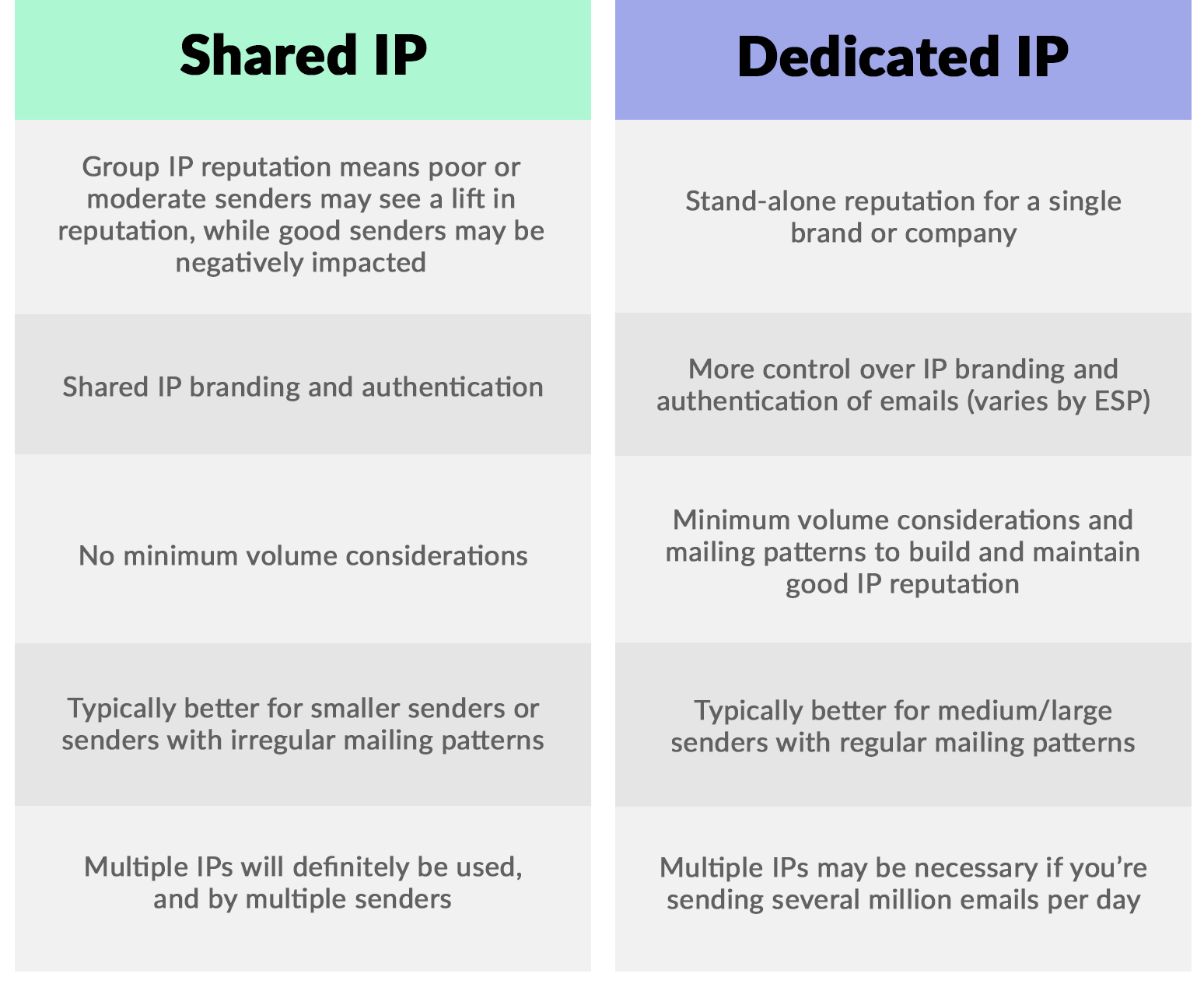Email Infrastructure and Service Providers
To be dedicated or not to be dedicated, that is the question.
minute read

Whether ‘tis better to suffer the slings and arrows of spam complaints… Oh, sorry, I didn’t see you there. There are lots of choices when it comes to choosing an IP address strategy that is right for your business, and they start with picking your email service provider (ESP). Some ESPs only use a shared group of IP addresses for all of their clients, while others cater almost exclusively to those desiring a dedicated IP, but most ESPs fall somewhere in the middle. Both of the configuration options have their own set of pros and cons for brands.
We are frequently asked, “When should I consider a dedicated IP?” We frequently (always) answer, there is no set time or mailing volume prescribing your need to move to a dedicated IP, but there are several things to consider. Let’s dig into them:
-
- Volume: When you are sending a consistent volume of mail (more than 500,000 messages a month), it’s probably time to start considering a dedicated IP, especially if you’re sending to a list of a few hundred thousand recipients several times per week. Certainly, when you cross the 4 million per month range, you should choose a dedicated IP. When your lists grows to be big enough that you are sending millions of emails a day the conversation should change to how many IPs should you have, our general rule of thumb is 1 IP for every 2.5-3 million a day you plan to send (e.g., 6M/day on two IPs, 9M/day on three IPs).
-
- Mailing frequency: If you mail only once per quarter, shared IPs are the way to go. This type of long inactivity means virtually no reputation metrics are available to you, and it will lead to long and slow delivery while you re-warm your IP/domain. Needless to say, this results in significant headaches. However, if you’re mailing frequency is more of a daily nature with tens of thousands of subscribers, you might be an ideal candidate for dedicated IPs, as there will be lots of data points on which to build reputation.
-
- Type of mailings: Are you sending both commercial and transactional emails? Having a dedicated IP for both types of mail as well as separate subdomains is an ideal setup (e.g., marketing.example.com and receipts.example.com). Having separate domains and IP addresses allows for separate reputation for the two email types. This prevents transactional emails from being stuck in queue behind your commercial emails. No one likes waiting for a password reset or two-factor authentication email.
- Regional norms: Dedicated IPs are now standard in North America, where email marketers tend to have larger lists and utilize more aggressive mailing practices required for individual reputation management. However, in the European Union and APAC regions, a shared IP setup is more standard as lists are smaller and the permission for data collection is more stringent.
How many IPs should I have for my mailings?
This is where the decision becomes a mix of a little bit science and a little bit magic. The logic is, the better your email reputation, the lower the number of IPs you need, but then you also need to consider how fast you think the mail should deliver to recipients. A publisher may not care if it takes six hours to send to their full database, while a retailer or daily-deal site might want messages sent to all consumers within an hour or two. Balancing the list size, the acceptable delivery timeline, and the reputation of the IP and domain will all become a factor. As a general rule, you should have one dedicated IP for every 3 to 5 million emails you send per day.
What are the key considerations when choosing either option?
What should I watch out for?
Unfortunately, we cannot share this information without a very important caveat: If your ESP has senders of marginal or poor reputation with dedicated IPs, even if it’s a relatively small group of clients, the entire IP range could be flagged by a blacklist provider. If your IP lands within the range, you’re going to be lumped in with the bad actors. Our advice is to split your transactional mail (receipts) and bulk mail (e-newsletters) across two IPs, preferably in different network ranges. Of course, scale appropriately based on the complexity of your email program.
Here’s our bottom line on shared IPs: If you send on a small scale, or simply don’t send email that often, the standard shared IP environment at most top-level ESPs may be beneficial. When mailing via a shared IP, sending with a unique DKIM selector and key will further help differentiate your emails from those senders utilizing the same IPs for sending mail.
Even internally here at Validity, we were discussing volume targets that should be considered when looking to move to a dedicated IP and we had a wide range of opinions and experiences ranging from 100,000 messages per month to 1M for the conversation starter. It is important to talk to your ESP, as they may have policies and rules in place for brands interested in a dedicated IP or remaining in a shared environment.
